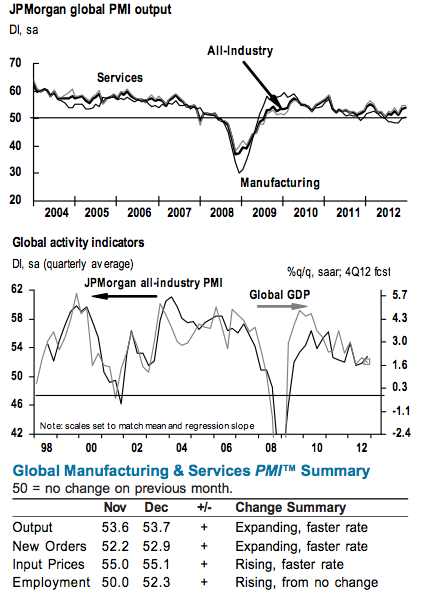Global private sector output expanded at the fastest pace for nine months in December, rounding off the strongest quarter since Q1 2012. Trends in new orders and employment also improved, but there were further signs of companies supporting output levels by working through backlogs of work.
At 53.7 in December, up slightly from 53.6 in November, the Global All-Industry Output Index – produced by JPMorgan and Markit in association with ISM and IFPSM – signalled expansion for the forty-first successive month. The rate of increase was broadly in line with the average for this period.
Growth was led by the services sector in December, where business activity rose at the same rate as November’s eight- month high. Manufacturing output also lifted higher, but the rate of expansion was only marginal and weak compared to that signalled for services.
The strongest rates of increase in all-industry business activity were signalled by the US and India. The Eurozone and Japan remained the principal drags on the global economy, with both seeing output contract further. UK economic output stagnated in December, and over the final quarter as a whole.
So, as with last week’s manufacturing data, we are seeing renewed strength in much of Asia and the US, but Japan and many parts of the Eurozone are moving in the opposite direction, as in Australia.
In the Eurozone itself German services are offsetting falls in manufacturing leading to slight overall growth but the news isn’t so good in the other large economies. France, Italy and Spain are all still on the slide, although the rate of decline is subsiding.
December saw output continue to fall in both the manufacturing and service sectors. Manufacturing remained the weaker performer, with production falling for the tenth straight month in tandem with weak demand from both domestic and export markets. Service providers reported a drop in business activity for the eleventh month in a row, although the rate of contraction eased to the slowest since July 2012.
There was a welcome return to growth for Germany, where a solid expansion of services activity offset ongoing contraction at manufacturers. Ireland continued to report a marked rate of expansion. France, Italy and Spain all remained in recession, but there was at least some brighter news from these nations, with rates of contraction easing in all three in December.
Incoming new business contracted for the 17th month and only Ireland could manage an increase in new orders. France and Italy look quite worrying in this regard with an accelerating rate of decline in both nations. Backlogs of work shrank across the board although the rate of decline slowed.
The overall contraction has again resulted in job losses. Although Ireland is seeing growth on the back of its good readings and Germany is showing some stability, France, Italy and Spain continue to shed jobs at pace.
As I noted last week, the Eurozone plan is based on the hope that the rest of the world can provide increased external demand to offset internal economic retrenchment caused by austerity. It appears that many of the Eurozone nations hope to replicate Ireland’s success, if you can call it that, but the country was always export competitive in the Euro and already had an economy that was US-focussed even before the crisis began. Spain, France and Italy are mainly dependent on each other and Germany, and with many Eurozone nations increasing fiscal tightening in 2013 I would expect further retrenchment to continue.
That being said, global growth is settling in by the looks of things so as long as the US can work through it’s own fiscal issues past March we should see that continue through 2013.
Eurozone and global reports below:
Global growth, with exceptions
Advertisement
Advertisement
